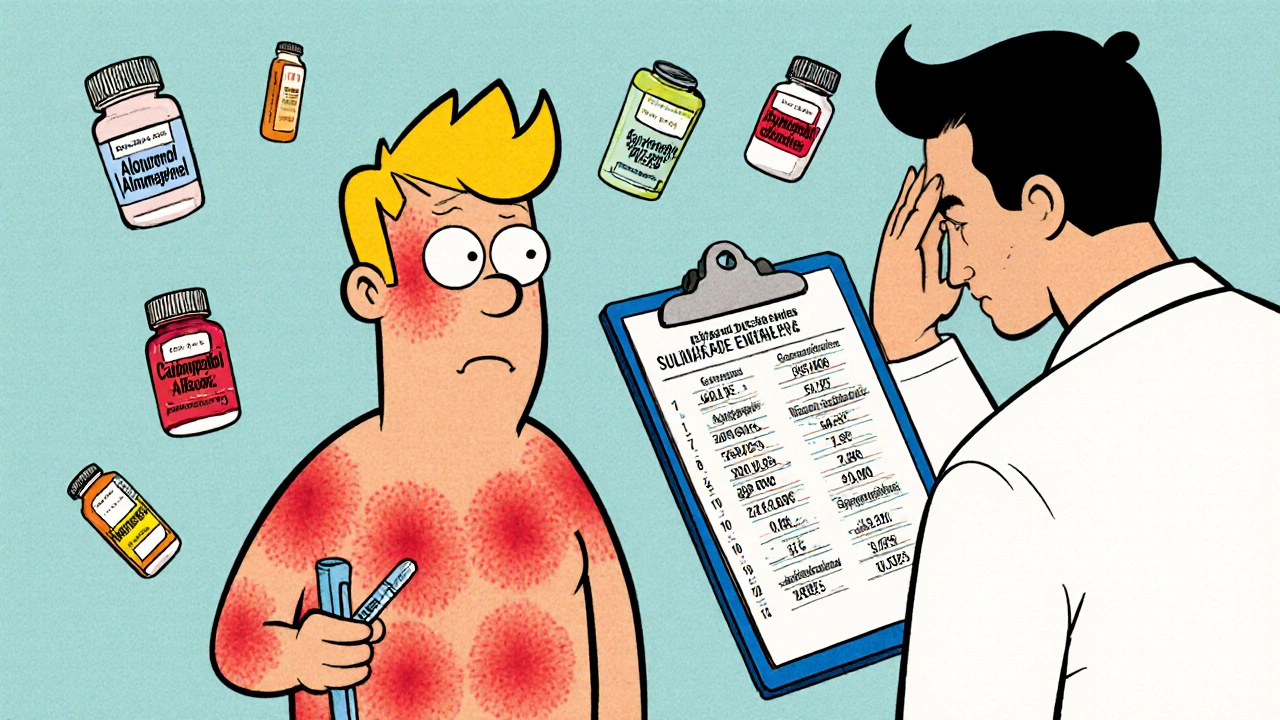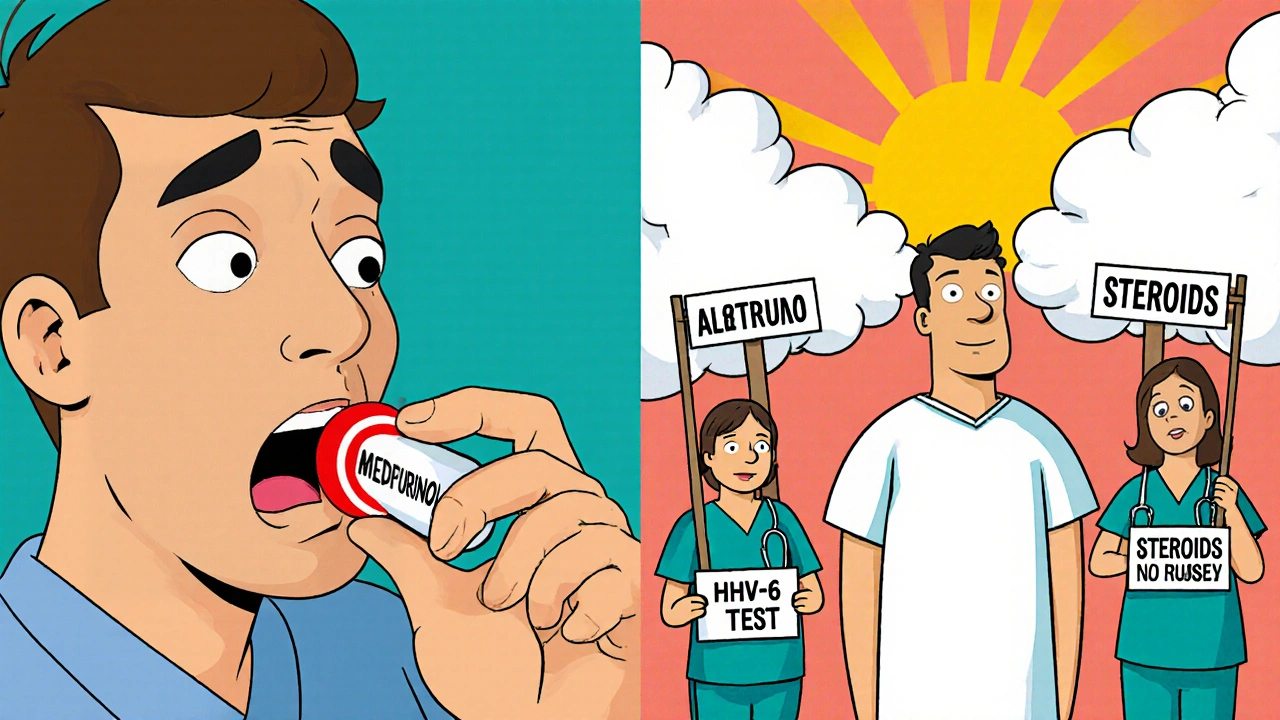Drug Reaction with Eosinophilia and Systemic Symptoms (DRESS): What You Need to Know

What Is DRESS Syndrome?
DRESS syndrome is a rare but life-threatening drug reaction that triggers a massive immune response, causing fever, skin rash, and damage to internal organs like the liver, kidneys, and lungs. Also called Drug-Induced Hypersensitivity Syndrome (DIHS), it’s one of the most dangerous types of adverse drug reactions, with a 10% death rate if not caught early.
Unlike typical allergic rashes that show up within hours, DRESS takes weeks to develop-usually between 2 and 8 weeks after starting a new medication. That delay is why so many patients and doctors miss it. People often think the rash is a virus, a cold, or a mild allergy. By the time the full picture appears-fever, swollen glands, and organ trouble-it’s already serious.
How Do You Know It’s DRESS and Not Just a Rash?
The signs don’t show up all at once. It starts with flu-like symptoms: fatigue, sore throat, fever over 38°C (100.4°F), and swollen lymph nodes. Then, within a couple of days, the skin erupts. In 80-90% of cases, it’s a red, flat, measles-like rash covering large parts of the body. Less often, it’s blistering, purplish, or bumpy.
But here’s what sets DRESS apart: it doesn’t stop at the skin. Blood tests almost always show eosinophilia-elevated levels of a specific white blood cell that fights parasites and triggers allergic reactions. More than 95% of DRESS patients have eosinophil counts above 700 per microliter. Atypical lymphocytes show up in 85% of cases, and liver enzymes like ALT often spike above 1,000 U/L-sometimes over 2,000, as seen in real patient cases.
Organ involvement is the real danger. About 70-90% of patients have liver damage. Up to 30% develop kidney problems. Lungs, heart, and pancreas can also be affected. One patient in a 2022 case report had AST levels hit 2,840 U/L after starting allopurinol. That’s not just elevated-it’s a medical emergency.
Which Drugs Cause DRESS?
Not every drug causes DRESS, but a few are known triggers. The biggest offender is allopurinol, used to treat gout. It’s responsible for 40-50% of all cases, especially in people with kidney disease. If your eGFR is below 60, your risk jumps to 1 in 200. That’s why the FDA now recommends genetic testing for the HLA-B*58:01 gene before prescribing allopurinol to high-risk groups-especially people of Asian descent, where this gene variant is more common.
Antiseizure medications like carbamazepine, phenytoin, and lamotrigine cause 20-30% of cases. Sulfonamide antibiotics (like sulfamethoxazole) account for another 10-15%. Even some antivirals and blood pressure drugs have been linked, but these are rare.
What’s surprising is that the reaction isn’t about dose. Even a single pill can trigger it. And once you’ve had DRESS from one drug, you’re at risk for reacting to others in the same class. That’s why avoiding all related medications after diagnosis is critical.
DRESS vs. SJS and TEN: What’s the Difference?
People often confuse DRESS with Stevens-Johnson Syndrome (SJS) or Toxic Epidermal Necrolysis (TEN). All three are severe skin reactions, but they’re very different.
- DRESS: Starts slowly (2-8 weeks), rash is widespread but doesn’t peel, eosinophils are high, organs are involved, HHV-6 virus often reactivates.
- SJS/TEN: Starts fast (1-4 weeks), skin blisters and peels off in large sheets, mucous membranes (mouth, eyes, genitals) are severely damaged, eosinophils are normal, death rate is higher (up to 40% for TEN).
Doctors use these differences to decide what’s happening. In DRESS, you won’t see 30% of skin sloughing off like in TEN. Instead, you’ll see a fever that won’t quit, a rash that lingers for weeks, and a blood test full of weird cells.

Why Is Diagnosis So Hard?
Only 35% of internal medicine residents can correctly identify DRESS in a case study, according to a 2020 study. Why? Because it looks like everything else: mononucleosis, hepatitis, lupus, even a viral rash.
Patients report seeing three or more doctors before getting the right diagnosis. One Reddit user described being told it was “just a virus” for weeks while their liver failed. A patient on the NORD forum spent 45 days in the hospital after her DRESS was missed for six weeks.
Doctors need to ask: “What new drugs did you start in the last two months?” That’s the key question. If someone’s had a fever and rash for more than a week, and they started a new medication 4-6 weeks ago, DRESS must be considered.
The RegiSCAR diagnostic criteria help. If a patient is hospitalized, has a rash, fever, swollen glands, and at least two organ systems involved (like liver + kidney), plus eosinophilia-it’s DRESS.
What Happens After Diagnosis?
The first and most important step: stop the drug immediately. If you wait even 24-48 hours, your risk of death goes up. Stopping the drug cuts mortality from 15% to 5%.
Most patients need hospitalization. Treatment usually involves high-dose corticosteroids-like prednisone or methylprednisolone-starting at 0.5 to 1 mg per kg of body weight. Treatment lasts 4 to 8 weeks, with a slow taper. Stopping too soon can cause a rebound, and the rash or liver damage can come back worse.
Some patients need more. In severe cases, doctors are now using drugs like anakinra (an IL-1 blocker) or tocilizumab (an IL-6 blocker) to calm the immune system. A 2022 study showed anakinra cut hospital stays from 18.5 days to just 11.2 days.
Infection control is critical. About 10% of DRESS patients get serious infections from bacteria like MRSA or fungi like Candida. Their skin is broken, their immune system is confused, and their defenses are down.
Long-Term Risks and Complications
DRESS doesn’t always end when the rash fades. About 20-30% of survivors have lasting organ damage. Kidney problems are the most common, with nearly 30% needing ongoing nephrology care. Liver damage can lead to chronic hepatitis. Some patients develop autoimmune diseases months later-Graves’ disease, lupus, or type 1 diabetes.
One patient in a 2023 Reddit post developed Graves’ disease five weeks after their DRESS resolved. That’s not rare. Studies show 5-10% of DRESS survivors develop new autoimmune conditions.
And then there’s the virus. In 60-70% of cases, HHV-6 (a type of herpes virus that’s usually dormant) wakes up 2-4 weeks after symptoms start. This may explain why some patients stay sick for months, even after stopping the drug and starting steroids.

What’s New in DRESS Treatment?
There’s progress. The European Registry of Severe Cutaneous Adverse Reactions (EuroSCAR) is testing a new diagnostic tool that combines HHV-6 PCR tests, eosinophil protein levels, and clinical scoring. Early results show it’s 92% accurate.
Genetic screening is already making a difference. In Taiwan, requiring HLA-B*58:01 testing before allopurinol use cut DRESS cases by 75%. The American College of Rheumatology now recommends febuxostat instead of allopurinol for patients with kidney disease-this could prevent 1,200-1,500 DRESS cases each year in the U.S. alone.
A clinical trial testing tocilizumab for steroid-resistant DRESS is underway, with results expected in late 2024. If it works, it could change how we treat the most severe cases.
What Should You Do If You Suspect DRESS?
If you’ve started a new medication in the last two months and now have:
- Fever lasting more than 3 days
- A widespread rash that’s not improving
- Swollen lymph nodes
- Unexplained fatigue or nausea
-stop the drug and go to the ER. Don’t wait. Bring your medication list. Say: “I think this might be DRESS.”
Ask for: blood work (CBC with differential, liver enzymes, creatinine), and mention HHV-6 testing if it’s been more than two weeks since symptoms started.
If you’ve had DRESS before, wear a medical alert bracelet. Keep a list of all drugs you can’t take again. Talk to your pharmacist and doctor before starting any new medication-even over-the-counter ones.
Where Can You Get Help?
The DRESS Syndrome Foundation offers a free patient navigator program that helps people find specialists, understand test results, and avoid dangerous drug combinations. Since 2018, they’ve helped over 1,200 patients, with 85% saying it shortened their diagnostic journey.
For families, the National Organization for Rare Disorders (NORD) has support groups and educational materials. You’re not alone-this is rare, but you’re not the only one going through it.